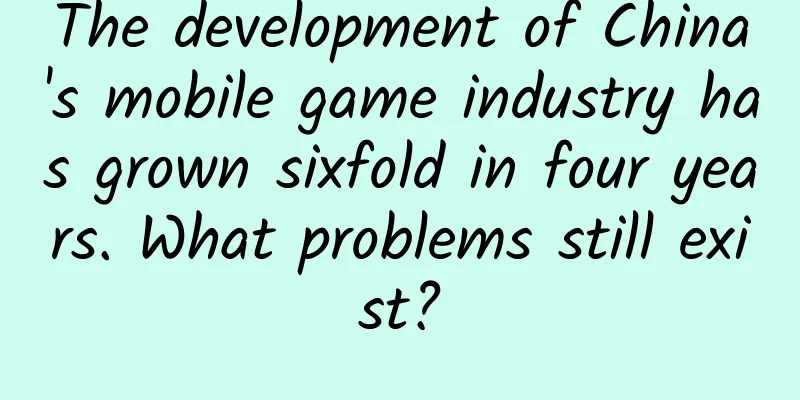The development of China's mobile game industry has grown sixfold in four years. What problems still exist?

|
On the subway during commuting, or at a crowded bus stop, you can easily spot people around you playing mobile games. They move their fingers quickly to connect the same patterns, or drag their fighter planes to avoid enemy fire, with expressions constantly changing with the plot... These small games make commuting less boring. Because they are short, flat and fast enough, many people who never play games have become players; because of social networks, through sharing and ranking, playing games is no longer a pleasure for one person. Available at any time, playable anywhere, shareable at will - playing games has never been so free and casual, and this change is spawning a huge consumer market. According to the latest forecast from Newzoo, a Dutch gaming data research organization, China's mobile gaming market will reach a size of US$6.5 billion (RMB 41.3 billion) in 2015, surpassing the United States to become the world's largest mobile gaming market. Last week, Niko Partners, an Asian market research company, released a new game market report. According to their calculations, China will also become the world's number one. In the past four years, China's mobile game market has soared from 6.2 billion to 27.5 billion. As an ordinary smartphone user, you may not realize that you have contributed a lot to it. If there is such a thing as an "Alipay annual bill", your experiences in the past few years must be extremely rich: you have chopped 8,645 watermelons, used 56 8-hit combos, and were blown up 283 times; you killed 13,288 pigs with birds, seriously injured 4,978 pigs, and directly bounced the birds into the ditch 97 times; your winning rate in Landlords has reached 33%, but your fingers and eyesight are not very good. You have only defeated 3% of your friends in Tampon Run, and you have never left the bottom of the list of daily elimination games. Therefore, we suggest that you stay away from elimination games and change to a mobile phone with more power... Behind these games is the Chinese mobile phone game market, which has grown sixfold in four years. This market is bigger and richer than you think. The growth rate has increased sixfold in four years. This is the best time for mobile games. If I were to describe the development of China's mobile game market in recent years in one word, it would be "fast". In 2011, the entire Chinese mobile game market revenue was only 6.24 billion yuan, last year the figure was 27.49 billion yuan, and this year, it is expected to increase by more than 14 billion yuan, reaching a staggering 41.6 billion yuan. Although well-known mobile device games such as "Angry Birds" and "Plants vs. Zombies" appeared as early as 2009, and Supercell launched "Clash of Clans", one of the most successful mobile games in the world, in 2012, the Chinese mobile game market was just beginning to "accelerate" at this time. At that time, countless Chinese mobile game developers wanted to replicate the success of "Clash of Clans", but all failed. You can see all kinds of Clash of Clans games with different names, such as "Chai Na Tribe" and "Pocket War". In the end, they were just a flash in the pan. In early 2013, a startup company, Joyo Technology, launched a mobile game called "My Name is MT". When everyone was trying to imitate American strategy games, this game set its sights on Japanese mobile card games. No matter how many people questioned that it copied World of Warcraft, its monthly revenue of 55 million was unmatched at the time. My Name is MT established the status of mobile card games in China. In 2013, "My Name is MT" remained at the top of the App Store's bestseller list for 267 days. Even Tencent's WeChat series of games and NetEase's "Fantasy Westward Journey" failed to break this record. To this day, card games are still the most popular game type in the Chinese mobile game market. A series of mobile games such as "My Name is MT" have caught up with the right time. From 2011 to 2013, the number of smartphone users doubled, from 220 million to 440 million. According to statistics from the China Internet Information Center, the growth in the number of mobile game players on smartphones is even more amazing. In 2012, it was 89 million, and in 2013 it was 310 million, an increase of 248.5%. Many people bought their first smartphone in the past few years and then opened a game on their phone for the first time. Social networks have boosted the popularity of games, turning users into players The surge in the number of players is inseparable from social networks. Just as Facebook once launched a wave of web and social games, WeChat has become the entry point for many people to access mobile games. In the second half of 2013, WeChat had 190 million monthly active users and more than 400 million total users. Just like Japan's Line, Tencent saw how a social software could directly and effectively let a game reach users. In August 2013, the match-the-links game “Tiantian Lianmeng” was launched on mobile QQ and WeChat, marking the first step of Tencent’s WeChat games. Then came the Tiantian series that everyone is familiar with. “Tiantian Kupao”, “Tiantian Aixiaoxiao”… For a while, it seemed that all the friends on WeChat were playing these games. They were keen to check the daily rankings and compete with each other. Word of mouth spread, and there was a trend of bringing families to play together. To this day, Tencent's games based on WeChat are still on the list. Games like "Tiantian Ai Xiaochu" and "Quanmin Assault" are representatives of Tencent's "Tiantian" and "Quanmin" series, telling everyone how important traffic is to mobile games. In the field of mobile games where the technical threshold is not so high, the advantage of traditional large companies does not lie in how good their team is in developing good games, but in allowing the vast number of smartphone users to easily see, understand and download these games on their devices. If you don’t have a strong channel, then buy something that is already famous However, not everyone has a social platform base like Tencent as a user acquisition capital. Fortunately, in order to let users know about your mobile games, in addition to building a social platform and app store yourself, there is another way: to create something that players are already familiar with. If you look at the recent best-selling game rankings, you will find that in addition to Tencent's series of mobile games promoted by WeChat, another major category at the top is various adapted games. The recently popular "The Journey of Flower" is one example. As a successful case of a novel adapted into a film and television and then adapted into a mobile game, this mobile game with more than 10 million active users and a monthly turnover of 200 million can best explain what is meant by "the value of an IP." Last year was called the first year of brand adaptation for mobile games. According to the "China Mobile Game Industry Trend Green Paper" released by 360 Mobile Assistant, the largest mobile application distribution platform, more than half of mobile games in the second quarter of last year had corresponding "brands". Novels, animations, movies, TV series, and games on other platforms are all sources of adaptation for mobile games. Last year, game developers, big and small, were buying products that had already become brands and could be developed into games. Rich developers, like Sohu Changyou, spent 150 million to buy the domestic animation "Qin's Moon" and the game adaptation rights of more than 10 novels by Jin Yong, and created many large-scale mobile games including "Demi-Gods and Semi-Devils". Those without money looked for products that had passed the intellectual property protection period, so "Romance of the Three Kingdoms" and "Journey to the West" became the best choice after they could not afford "Naruto" and "One Piece". For a time, various "XX Three Kingdoms" emerged like mushrooms after rain. However, buying a good brand can only help you win at the starting line. As for how fast you can run in the end, it still depends on the game itself. At the end of last year, the top-ranked mobile game adapted from an online novel was "Barbarian Chronicles", which ranked 107th - this is not quite consistent with the original novel with over 100 million hits. Choosing a good source, making a good game, and making players willing to pay for it is not in vain. Choose the right game type and target the right audience, and players will be more likely to spend money It is not easy to get Chinese players to spend money. China has the largest number of mobile game players in the world. According to the latest China Game Industry Report, as of the first half of the year, the number of mobile game users in China reached 366 million, about twice that of client games, and is expected to reach 420 million by the end of the year. However, a data survey from Newzoo shows that the average amount of money spent on games by each player in China is only $10 per year, which is about one-eighth of that spent by players in the United States. Although there are many people, not many are willing to pay. Relatively speaking, the mobile market is slightly better. If we calculate based on the expected number of mobile game players and the revenue of the entire market in 2015, the average spending per player is around $13. More than 46.6% of players will pay for mobile games. Even 4% of them spend more than 3,000 yuan on mobile games every month. In the gaming industry, there is a term for these high-paying players: "White Whales". In China, the spending power of mobile game "white whales" far exceeds that of American players. Of course, this is related to the fact that console games still dominate in Europe and the United States. Similarly, compared to the love of strategy games (such as "Clash of Clans") by European and American players, Chinese players love role-playing games (RPG) more. Whether on Android or iOS, players are very willing to pay for such games, with an average monthly payment rate of 3.9% and 4.4%. Compared with strategy games that focus on gameplay and emphasize long-term spending, RPG games emphasize game content: how gorgeous the graphics are, how rich the plot is, and how attractive the subject matter is. These are the reasons why Chinese players love and pay for them. This is also the reason why female players love mobile games. The proportion of female mobile game players has increased year by year, and the proportion in subcategories such as puzzle, simulation management and education has exceeded that of male players. Moreover, there are more female players in the age group of 36-55 years old - don't underestimate the ability of aunties, in addition to speculating in gold, they are also keen on playing mobile games. And the aunties are also quite rich (do they really make money from speculating in gold), among those who pay more than 5,000 yuan per month, the number of female players is 1.3 times that of male players. Which companies are the most profitable in the Chinese mobile game market? Who do the players pay their money to? A lot of company names must come to your mind, but they may be a little different from what you imagined. In the mobile game publisher revenue list for July compiled by App Annie, Tencent undoubtedly ranked first. In the second quarter of this year, Tencent's mobile game revenue was 4.5 billion yuan. Although the growth rate of mobile game revenue slowed down due to the small number of new games released in the first half of the year, after July, Tencent's newly-distributed game "The King of Fighters 98 Ultimate Battle" quickly reaped the rewards. It was released in mid-July and ranked tenth on the monthly best-selling list at the end of the month. Tencent has its own developed Tiantian and Quanmin series, new games such as "Legend of Mir 2" and "King of Fighters" distributed by agents, and channels such as QQ, browsers, App Store and WeChat. From development, distribution to download channels, Tencent has its own complete industry chain, making it the most profitable game company. Compared with Tencent, NetEase does not have its own application platform, but its strong resources in development and distribution have allowed it to maintain the second place in App Store revenue. Although it was only in April 2014 that they launched their first mobile game, Mini Westward Journey, their slow pace allowed them to create Fantasy Westward Journey, which has dominated the bestseller list for more than three months since April. In terms of distribution, Blizzard's "Hearthstone" is a cash cow for NetEase. NetEase CEO Ding Lei said that "Hearthstone" has the largest number of users and revenue in China. Although it is still a long way behind Tencent, it is firmly in the second place. In addition to Tencent and NetEase, some companies that seem to have little to do with games are also taking a share of the rapidly growing mobile game market, such as 360. 360 plays the role of a distributor in the entire mobile game industry chain. After a mobile game is made by a developer and handed over to a publisher for promotion and distribution, it will eventually be handed over to a distributor - that is, those app stores and download platforms for distribution. 360 Mobile Assistant, Baidu Mobile Apps, and Tencent App Store all do the same thing - although they are really annoying, constantly recommending various games and apps to you. The largest of these is the 360 series, which includes 360 Mobile Assistant, PC Manager and Browser Application Search. No matter how you evaluate 360 Mobile Assistant, you have to admit that it is currently the largest application distribution channel in China. According to 360's second quarter financial report this year, the total number of smartphone users of its mobile security products reached 799 million, and the value-added services from the game platform business reached US$122 million. The revenue of 122 million US dollars is enough to surpass some large companies specializing in game distribution, such as China Mobile Games and Kunlun Games. This is because, in the entire industry chain, channel dealers receive the largest share. This ratio is generally around 60% to 70%: for every 10 yuan you pay for mobile games, about 6 yuan goes to the platform where you download the game. Sure enough, in this Internet age, whoever is closest to the users gets the most money. Although it has become the largest market, there are too many problems in this industry Although some people may be puzzled by the fact that channel dealers make a lot of money, a complaint on Zhihu pointed out the dilemma that caused this situation: If you ask me to sell dog shit in front of a supermarket, I won’t do it even if you give me 99% of the profit share. What this means is that the reason for this situation is that mobile games themselves are too bad. In 2013, an average of 6 mobile game developers were established every day. Many game developers, with the mentality of making a quick buck, made a bunch of identical "Three Kingdoms" or "Ninja", leaving everything to publishers and channel operators to build their brands, pay more money to get their games ranked higher, trick users into downloading, and then quickly complete the first payment before leaving. As a result, professional ranking manipulation companies emerged, helping those games to improve their rankings through massive downloads and fake payments. At the end of August this year, Apple once again cleaned up the App Store rankings, and a large number of game apps were removed from the list or removed from the shelves, including works from major companies such as NetEase and Changyou, because these games were suspected of ranking manipulation. Games that made it onto the list by their own strength are not necessarily innocent. The mobile game "The Journey of Flower" is so popular, but it has been accused of plagiarizing another mobile game "Tai Chi Panda". Although the art and plot have changed, the game's UI layout, the teaching and development of the gameplay, and the character lines and game announcements are basically copied. Snail Digital, the developer of "Tai Chi Panda", has taken "The Journey of Flower" to court, but whether it can successfully defend its rights remains to be determined by the law. Another popular game, Dota Legend, is more like a Rashomon. First, Dota Legend sued Ucool's Heroes of Charge for plagiarizing the game code, and even produced evidence hidden in the game; then Blizzard sued Dota Legend in Taiwan, claiming that it involved plagiarism of character images. The mantis stalks the cicada, while the oriole is behind, which is also a bit ridiculous. What is also worrying is that the IPs that were once worshipped as gods are not so useful anymore. Now, basically, movies and novels are marketed together with mobile games. For example, "The Empress of China" and "Black Cat Sheriff: Emerald Star" both launched mobile games of the same name when they were broadcast, but no one played the games before the TV series was finished and the movies were offline. And the parkour game in "Where Are We Going, Dad?" How many people downloaded it and deleted it not long after? This game is now ranked outside the top 1,000, which is not much different from non-existence. However, positive things are also happening. Last month, the domestic independent mobile game "Carp" broke into the top 20 in App Store downloads. The fresh style and gameplay made people feel bright. Players' tastes are beginning to become more picky, and they are no longer satisfied with just a casual game like Three Kingdoms and Journey to the West. More and more major manufacturers that mainly make client games are entering the mobile game market, bringing in their previous habit of focusing on a single product. Fantasy Westward Journey proves that this kind of heavy RPG work can also maintain vitality for a long time. A large number of online game adaptations such as Legend of Mir 2 and Swordsman Love 3 seem to be able to make this rapidly changing market more stable. As the market grows, it seems inevitable that things will get better and better. Regardless of whether the Chinese mobile game market becomes the world's first or second, the biggest relationship with players is whether it can bring us more fun games. Especially when the channel dividends gradually decrease and users become more picky, the real competition begins. |
<<: Summary of predictions for new products at Apple's conference tonight
Recommend
“Deregistering your mobile number is equivalent to betraying yourself”? @Everyone, you must do these things before changing your mobile number!
These two days Topic: "Canceling your phone ...
Unlocking a new experience of smart, fun and fashion, WM Motor grandly landed at the 2020 Chengdu Auto Show
[July 24, 2020] "The number one smart car po...
After studying 200+ brand cases, 50 product and marketing thoughts were summarized
Regarding brands, new consumption, and marketing,...
An article to thoroughly understand the Android event distribution mechanism
Preface In Android development, we often encounte...
Design and implementation of the 2022 Spring Festival Douyin video red envelope system
What we did Business Background During the Spring...
China Automobile Dealers Association: Analysis of China's imported automobile market in June 2022
(I) Supply: After three years of decline, automob...
This is the secret of astronauts losing weight丨Tutu Science Fiction
Vocabulary weight scale rocket Gravitational acce...
Brilliance Automotive Group has finally learned something from BMW. Can the Brilliance Automotive Group V7 create a miracle?
When talking about Zhonghua, what do you think of...
YouTube video marketing, tips to improve ad conversion rates!
Are you struggling to grow your YouTube channel? ...
Planting trees at an altitude of 3,600 meters, the barren mountains are turning green!
"Gelsang flowers are in bloom, trees are lus...
Cross-border marketing creative advertising case!
What is cross-border marketing ? As American adve...
Community operation: How to build a high-quality community from 0 to 1?
Everyone who works in the Internet industry knows...
What would happen if you put a frog in a magnetic field?
Before, people always said that meeting someone w...
How can individuals register and promote in Meituan Alliance? How to obtain personal red envelope promotion link?
Since the outbreak of the epidemic, the food deli...









